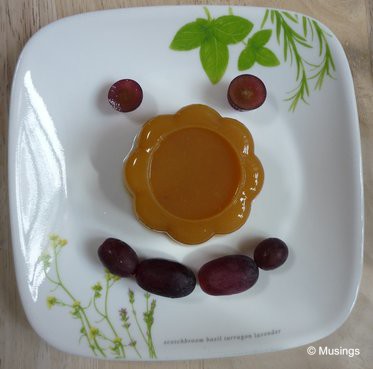
I think I’m a little obsessed over creating new agar-agar recipes at home. Really enjoy the fun of experimenting with this seaweed gel. I have been reading up a bit on its properties and the effects of temperature and pH on this natural food. There seems to be some confusion over this type of gel as some say that it is made up of proteins. From what I’ve gathered so far, agar-agar (or kanten in Japan) is made up of carbohydrates, specifically polysaccharides. And for the weight-conscious folks, good news: these polysaccharides are poorly absorbed by our digestive system and hence, extremely low in calories. They are a good source of folate, calcium, iron, magnesium, potassium and manganese.
Actually, what prompted me to embark on this journey of self-discovery is the general lack of online agar-agar recipes available that use fresh fruit juices. The agar-agar recipe book I have is also lacking in this area. Traditional agar-agar recipes call for the use of syrups or artificial flavourings to achieve fruity flavours but I prefer something closer to nature for the family.
The general practice in making agar-agar is to bring all ingredients to a boil before allowing it to cool down. This method is necessary and advantageous. It is necessary as agar-agar powder only dissolves in boiling water. The advantage is that most bacteria will be killed in the boiling process and hence the agar-agar can keep fresh longer. However, boiling will alter the taste and texture of fruit juices. I experimented on adding fruit juice after boiling the agar-agar mixture and it works. Now, the only downside is that the agar-agar should be consumed within 1-2 days. I recommend consumption within 24 hours. Yay, now I can have my fresh fruit agar-agar and eat it. :)
Mango ‘n’ Grape Agar-Agar Recipe
Ingredients (makes 3 small cups)
- Mango flesh – 100 g (I used Thai honey mango for its sweetness and little fibre)
- Red, seedless grapes – 50 g (try to get the sweeter variety, if not, just add more sugar as desired)
- Agar-agar powder – 3 g
- Sugar – 30 g
- Water – 150 ml
Method
1) Blend mango and grapes together until smooth (it is okay to have fragments of the grape skin). Set aside.
2) Place agar-agar powder, sugar and water in a small pot and bring to boil using medium heat. Stir every now and then while waiting for boiling to occur.
3) Once the agar-agar mixture starts to boil, the previously translucent mixture becomes a clear solution. This is an indication that the agar-agar powder has dissolved in water. Turn off the flame and let the agar-agar solution cool down briefly for 2-3 minutes.
4) Carefully pour the blended fruit juice into the agar-agar mixture and stir to mix everything evenly.
5) Pour out the fruit juice-agar mixture into cups and let it cool to room temperature. Cover the cups with cling wrap and chill them in the refrigerator for at least 2 hours before serving the refreshing dessert :D
The verdict: A nice and soft, fruit-combo taste which all of us liked.
Warning: May not suit everyone’s palate! :)
May I know the brand of the agar-agar powder u used?
Hi Wendi,
I have been using Swallow Globe Brand. I’ve been curious to try out other brands… one brand at a time. :)
I forgot to add that I always buy the colourless agar powder as I prefer natural colouring from the fruits…even though when the resultant colour may not be as visually appealing! :P
Hi Ling
Can I find out for the agar agar, I assume the flavour comes from the fruit as well and not the artificial flavouring?
Just curious, at what age have you started your gal on agar agar? So far, we let her taste a little of jelly.
Hi Theresa,
Yes, the recipe mentioned here is 100% natural; both flavour and colour are imparted by the fruits. Even the agar powder is from natural sources, i.e. seaweeds. Just remember to choose the colour ‘clear’ when you buy the agar agar powder. I used the Swallow Globe Brand which contains only the agar powder.
I can’t remember the exact time when Hannah had her first taste at agar agar. According to my blog records, it was around 2 years old. I can’t find any recommendation for consumption of agar for toddlers on the Internet. IMO, as long as the child can chew and swallow properly, eating agar agar is fine. Just like any other foods, do ensure that your child eats it in small chunks to avoid choking.